
|
Student's Study Guide for Lesson Two
by Dr Jamie Love |

|
 and
and  licensed under a Creative Commons Attribution-ShareAlike 4.0 International License.
licensed under a Creative Commons Attribution-ShareAlike 4.0 International License.

|
Student's Study Guide for Lesson Two
by Dr Jamie Love |

|
The ____ ___ is a series of stages through which a eukaryotic cell passes between divisions and it is composed of three stages easily identified through the microscope.

| 1. Interphase between divisions _______ seems to be happening. |

|
2. Nuclear Division is when the genetic material is divided and you can ___ the chromosomes.
Two types of nuclear division - mitosis and meiosis. Therefore this is often called _ _____. |

|
3. Cytokinesis divides the cytoplasm of the mother ____ into two daughter _____.
This is "true" cell ________. |
Interphase dominates the cell cycle and is often called the " ___ phase" in the cell cycle because it represents a period in which nothing seems to be happening. We often abbreviate it as _ phase.
DNA is ___________ during G phase and it divides G phase into two other gaps (separated by the period of ___ synthesis).
So, interphase (G phase) is subdivided into
|
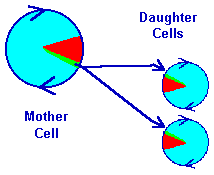
|
(If a cell had 1 picogram of DNA at G1 how much DNA would it have at G2?)
[ _ picograms.]
|
Interphase occurs _______ (both nuclear and cellular) divisions.
Easily identified through the microscope because the nuclear envelope is ______ throughout interphase
|
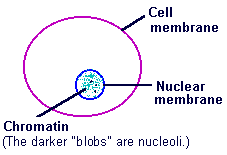
|
|
G1 = "_____ interphase"
Cells in G1 have only ___ centrosome.
Centrosome is the major organizer of chromosome ________
in M phase.
|
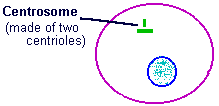
|
During S phase each single chromatid (inherited from the previous nuclear division) is __________ to give us the identical sister chromatids we see later on as _ -shaped chromosomes.
|
G2 = "____ interphase"
Centrosome is duplicated so by late G2 the cell has ___ centrosomes. It is crucial that the centrosome __________ during G2 because a cell must have __ centrosomes to guide the chromosomes during the M phase that follows. |
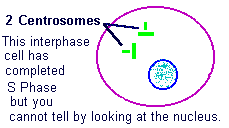
|
Cells entering cytokinesis have ___ nuclei (from M phase).
During cytokinesis the _________ is divided.
This is "true" cell division.

|
Animal cells do not have a ____ ____ so they divide by a method
called furrowing.
During furrowing the cell membrane puckers inward along the cell's "______" as if an invisible thread were tightening between the two parts. Eventually the furrowing pinches the cell in two. The "thread" is actually fibers of proteins attached to the inside of the cell membrane and they constrict like a ______.
Plant cells have ____ _____ so they cannot divide by furrowing.
|
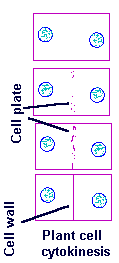
|